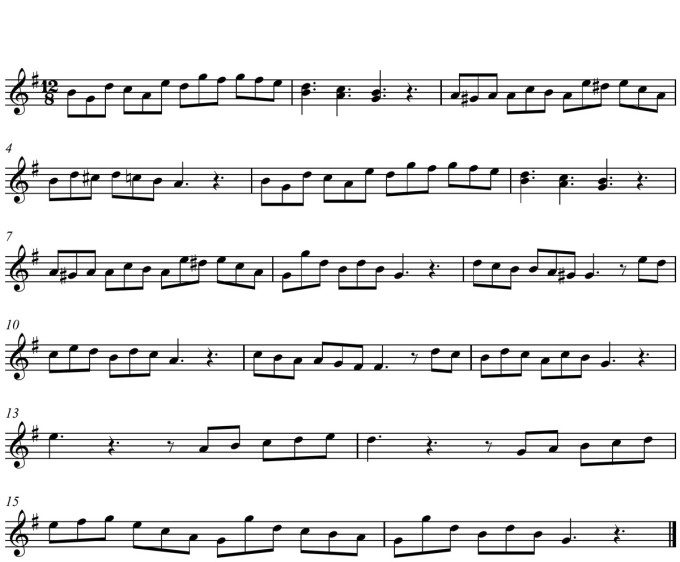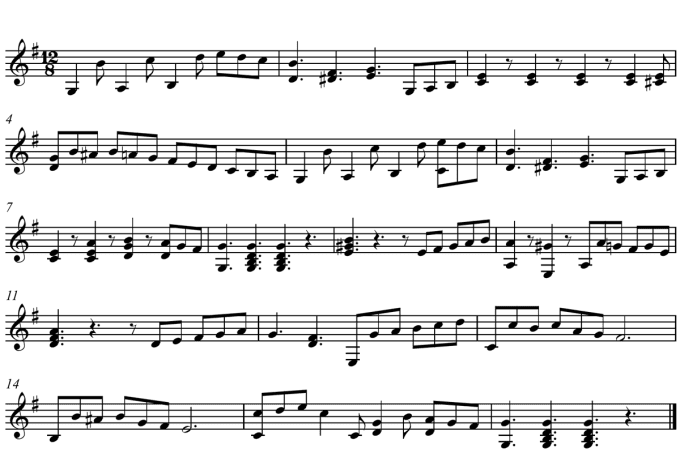This a particularly beautiful duet by Carulli and a little preview of the Notation and Sight Reading course for Level 2. Each part here is at mm. 74 so it will certainly be a sight reading challenge! Both parts are provided so you can swap over when you like.
The piece is in the time signature of 12/8 which has four main beats which are divided into three eighth notes. So, you can still count it in with four beats ( a lot easier than counting to twelve!) Don’t let it confound you with such a high number, essentially it is like two 6/8 measures stuck together.
Once you have played it a few times, experiment with using fingerings higher up the fretboard. There are a lot of possibilities and opportunities to make unique expressive phrases.
Guitar Part 1

Accompaniment audio
If this was a bit beyond your level of reading, become a member here! Inside the CGC membership, you will have access to more duets and play along exercises that will help you improve your reading skills.


Love the duet! Please do more.
Just got a chance to look and listen. This is a wonderful idea. Please do more of the same?
Fantastic!!!! I played it on guitar and on the Recorderand sounded great. I would love to see more of it. I am a music education student and music teacher in Vitoria,ES, Brazil. I would like to know more about your skype lessons since I am already quite ahead on my guitar playing and quite frankly there is no one in town to take me to the next level. I believe you have something for me as an educator and player. I am interested in strategies for group teaching or ensemble teaching for the guitar. I would also like to look at the possibility of you holding a master class-seminar around here sometime so please inbox me or email me with details about how to proceed. (Hopefully not too $$) I am a musician too and a father of four and I am trying to create a bridge of international level players and educators to come down to spread the joy unfortunately there sometimes a bit of resistance from local government and institutions so I would probably privately fund this initiative. Keep it up Mate!!!
Sincerely,
Gee
from BR.
Lovely, and so much fun to play. Ok, truth is that I am still working on playing the second part at full speed, so feel free to take a long coffee break while I catch up . Seriously, I appreciate that you provided both duet parts as well as the metronome marking (the latter definitely makes it easier to do offline practice).
One question: In the first guitar part I several times hear this cool little flourish that I don’t know how to replicate. Could you possibly explain how to do it or maybe post a little video demo? The first three occurrences are measures #1 (going from D to G), #3 (A to E), and #5 (D to G).
Oh, and in case any of your students are from the Houston area, check out the Texas Guitar Quartet in concert Apr 11 in The Woodlands.
Kept messing around and (accidentally) figured out how to do the little “flourish” (see my previous comment). SO COOL.
WOW!
The beauty of this method of teaching here at this website (venerated) is that the pull of the duet gathers in like a magnet all of the elements needed to actually play it and make it sound nice. It must be mentioned that the melody is engrossing while at the same time the accompaniment weaves in to reinforce the turns of the melody and the fineness of the rhythms.
However, the underlying purpose in this course on sight reading and notation is met here in a most centered way. The musical moments are being captured through visual means (notes on a staff) that are more one-to-one with the music since one is not following a map of the strings, divided up into frets for a nameless and therefore second-order or once-removed remoteness as in tabs. Instead, actually reading the score is not only first-order and one-to-one with notes by name, consoling after so much time in “tabland”; but also, it is reinforcing when one starts to fall back onto memory that creeps in almost unnoticed, and at that point one starts to play into nothingness — not knowing where to go next unless one reads the actual notes! Sight reading becomes now reinforcing. This makes the day. To be led into greater sight reading with the added power of a beautiful melody with harmonious accompaniment just drives one to capitalize on sight reading where before notes stood in the way under the pressure of inspiration to learn a piece at all costs. Now the cost of learning a piece is simply reduced to unity — one unifies with the score itself and does not feel abject that tabs are only second-best in a certain analytical sense. It is like coming home to music on the guitar in my book.
Fundamentally, if the eye is already trained for music scores as is mine in singing, there is no match for returning to direct notation on the classical guitar as compared to tablature. By observing the notes on the staff, one can visualize the pitches as they change. An interval between notes is almost instantaneously cognized as they are arrayed on the staff. This is actually a form of quantification, is it not? Music notation is a measurement for certain that is available so that one can intuit the pitches as they change and relate to one another in sequence with all the timing perfectly appended.
As I work on this fine Carulli duet, and I find myself repeatedly NOT being able to do without reading the notes as I play, this experience in learning is astonishing and totally welcome. As one conquers each little hurdle to perfection in this piece, that one being I, for example, one is lifted into a new level of sight reading by the sheer force of the dynamics of the music being rendered by one who knows: that one being Simon. As a result of this playing in unison with a teacher who knows and has arranged the actual piece, one has achieved a new platform for learning music, musicality, and all the elements that work together to make a rendition happen. This is a gift to an earnest student such as I am. Sing praises to this devoted teacher, for he fills in a void for those who would emulate the refined music he makes even as he teaches us here at Classical Guitar Corner. As if some powerful gravitational force were upon us, we are inexorably drawn to learn more and to make more and more music. I for one march along the sought-out path to perfection in music on the classical guitar, happily seeing the light of the way with the tools here at hand. Thank you.
I hope that by describing this experience herein others will find the same light. At the same time one is developing musical ability in this course, one is now also learning a very fine new piece by Carulli, a composer whose name I always used to hear on classical music radio in NYC. I never could hear enough of Carulli. This is a joy.
This is a great little duet and loads of fun to play. What a fantastic way to learn this is.
Well. That’s sorted then.
When this first appeared on the website, my friend and I decided to learn the parts so that we could play together. Great plan. he had been playing for some years and I had only just bought a classical guitar and come back to classical guitar after a break of about thirty years – and I was never all that good at it but in retirement you have to do something to keep your brain going!
He asked me which one I wanted to learn and I made a snap decision to learn what looked the simpler one. Part 2. Silly me.
I have worked tirelessly for weeks and weeks since it was published, and had to work out routines to do things like the D on bar 11 which stretches the hand very nicely thank you.
I have found it extremely useful to do a lot of work with scales and certainly found it a benefit using higher positions rather than rely on open strings. The D B on bar 2 has been the greatest challenge because that part is up there on the fifth position, and w only way to get to it accurately is to practice over and over again.
One thing I did work out (eventually) was that I can only make the first bar work into the second bar if I use my middle finger of the left hand on the second string first fret for the fourth note (C). That is the only way to have my fingers in the right position for the second bar.
Another thing that sounds rather nice is at Bar 9, the key change, to play much nearer the bridge and change the tone to emphasise the difference.
It’s been a journey but the immense delight in playing the second part in duet with the performed first part on the web page has justified the hard slog, sore fingers, buzzing strings and frustrating mistakes. I can’t wait to sit with my friend and perform the duet for our other friends and wives.
Today I finally played the Part 1 music and it is so easy compared to Part 2 that it only took a couple of tries to get it all the way through. Our joint performance will probably be by playing the duet twice but swapping parts half way through, and also using different parts of the strings to change the tone.
I really look forward to the next duet, in fact I am going to search some out. This exercise and challenge has brought me to a level I never dreamed I would reach and I am very grateful indeed. It’s a wonderful website.
That is a wonderful story and I loved reading it. Hearing about your journey and the things you tried and had to do was very interesting and has given me a lot of encouragement to try and find another guitarist who is interested in playing classical to do something similar with. I also particularly liked hearing that you intend to do a little performance for family and friends. That’s a great motivation and is something that will not only bring pleasure to you but others as well. Thumbs up to you and your friend.
Tony
Dear Enrico,
I am so glad you enjoyed it! I have been working on more and the will be released soon. If you are on the mailing list then I will notify you when they are launched.
I have just finished playing the duet “with you” , we did great by the way,
and when it was done, I wept.
It is so indescrible, so difficult to explain how it feels to collaborate with someone and then for me to achieve, even to this level, (*mind blowing*)
I will say I played so much better when I had to keep up, listening to the second guitarist- it was like my fingers finally found their way.
As David Russell said, there are some things you need to experience, and I now understand, for that light to on in your head…
So Grateful for your time you devote to this community of classical guitarists.
Thank you neighbor, talk soon,
Karen